There is much debate surrounding the subject of man-made vs natural fruits and vegetables. A lot of products that we consume today are genetically modified.
But, is cauliflower man-made?
In short, yes, cauliflower is man-made. However, the story of how exactly it became the humble vegetable we know today is quite fascinating indeed. If you wanna know about that you need to read on.
Here I wanna add that genetically modified (or man-made) doesn’t mean that it is bad for us, there are some fruits and vegetables (like cauliflower) which were crossbred to create easier-to-grow versions of themselves.
For example, before being tinkered with broccoli and cauliflower were originally wild mustard plants (Brassica Oleracea).
It was then modified to create the white-headed cauliflower and the longer stemmed, green-headed broccoli that we are used to.
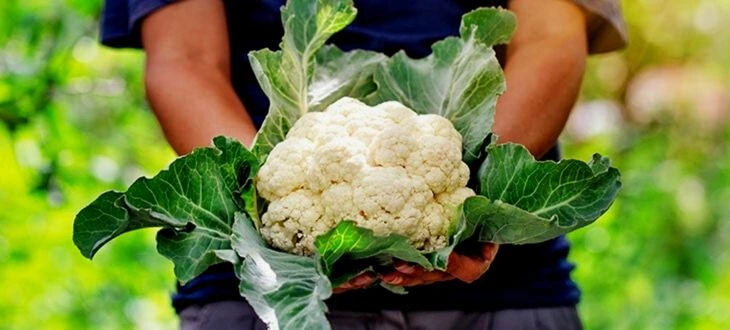
Table of Contents
Is Cauliflower Man-Made or Grown Naturally?
Cauliflower is, in fact, man-made (genetically modified), but we need to have a look at the process of how it has been made possible.
Cauliflower has been noted to have been around since the middle ages of the 12th and 13th centuries.
It has long been associated with the small Asian (technically, but known as European) country of Cyprus. History has taught us that 2 botanists that go by the names of Ibn al-‘Awwam and Ibn al-Baitar claim Cyprus as the cauliflower’s place of origin.
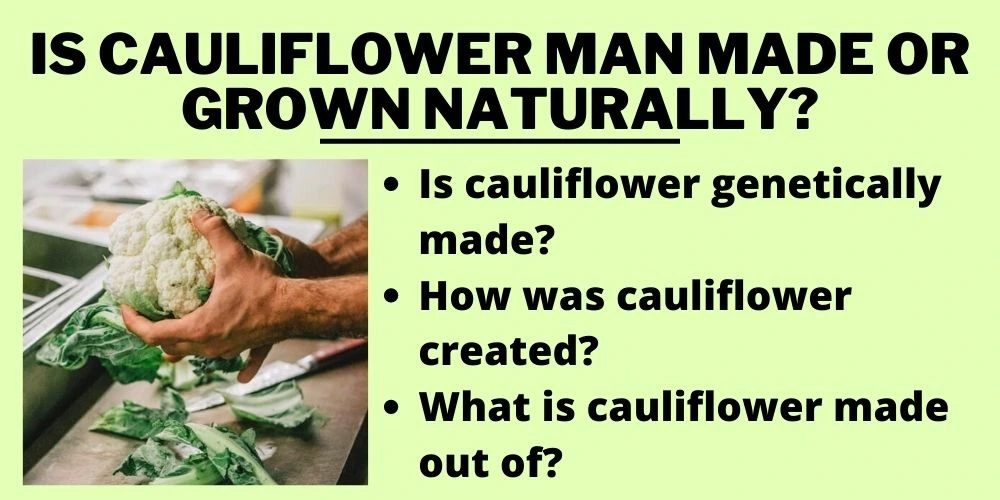
Of course, it didn’t always look the way it does today. It started as a wild mustard plant. That’s because it has been selectively bred to suit our needs as humans.
Is cauliflower genetically made?
Yes, it is genetically made. In fact the look of the cauliflower has changed dramatically over time. In the beginning, it resembled a green, thin stemmed weed with broad green leaves and yellow flowers.
This wasn’t so appealing to the roman farmers as it was hard to control the wild mustard. As they planted it, it bushed out and took up a lot of space that they couldn’t afford to lose.
So they began tinkering with the wild mustard.
How was cauliflower created?
The wild mustard plant was not only tough to control in minimal space, but it was also not so appealing and extremely hard to serve up to the masses in the form of food. The change was needed. So, those who knew how began to cross breeding.
It took time, but the process assisted the progression. It took over a hundred years to turn the wild mustard plant into the cauliflower.
As they were altering the form of the original plant, they were also able to create some other vegetables, including broccoli, cabbage, brussel sprouts, etc.
What is cauliflower made out of?
Cauliflower is made out of years and years of trial and error and mutation and modification of the wild mustard plant. Those in charge used the plant’s flower buds to form cauliflower and broccoli.
They used the leaf buds to form the more leafy vegetables we now know as cabbage, kale, and brussels sprouts. The lesser-known kohlrabi was created from the stems of the mustard plant.
Which is healthier, broccoli or cauliflower?
Cauliflower and broccoli are both extremely healthy cruciferous vegetables from the same Brassicaceae family.
Aside from being from the same family, not only do they look dissimilar, but they have quite different nutritional benefits also. Let’s have a look at both in comparison with some in-depth facts.
Broccoli
Nutrients
- More calories.
- Rich in folate and manganese (Slightly more than cauliflower).
- High in vitamins A, C, and K.
- lower saturated fatty acids and higher polyunsaturated fatty acids.
- Great natural protein source.
- Calcium.
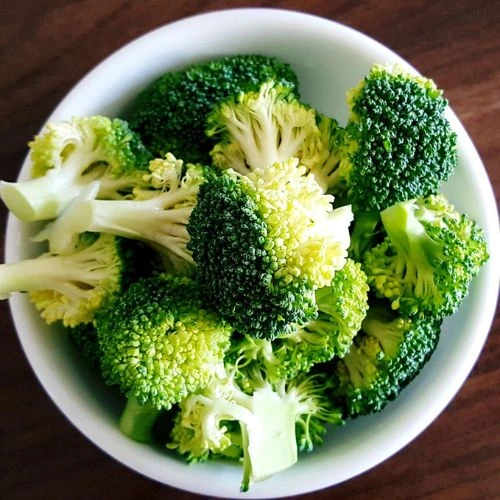
Benefits
The higher manganese content in broccoli is great for those with arthritis and weaker bones as it helps to improve overall bone density. The considerably higher amounts of vitamins C and K in broccoli give it extra checkmarks.
Vitamin A helps strengthen the vision, and vitamin C improves heart health and skin. Vitamin K, on the other hand, regulates blood clotting and improves bone strength.
The lower saturated fatty acids and higher polyunsaturated fatty acids help keep the body fuller for longer due to high dietary fiber. The protein in broccoli can help boost the body’s metabolism.
Cauliflower
Nutrients
- Lower calories.
- Rich in manganese.
- Also contains vitamins K and C but less than broccoli.
- Great natural protein source.
- Calcium.
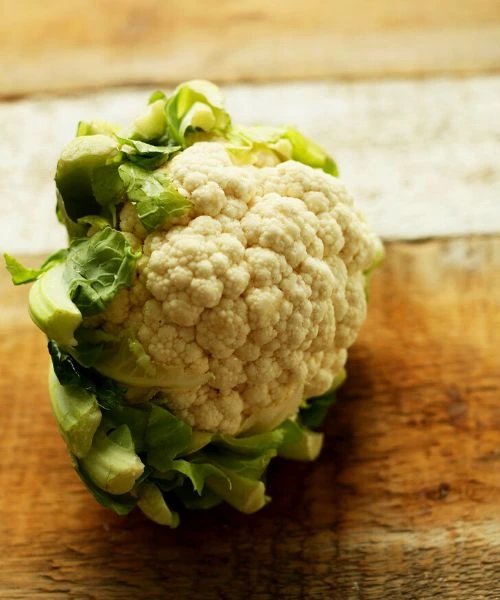
Benefits
The lower calories in cauliflower make the vegetable much more appealing to those on a weight loss journey. Similar to broccoli, Vitamin K is great for assisting in strengthening bones as well as maintaining blood clotting.
Vitamin C is prime for skin and heart health and overall immunity. The natural protein provided gives a welcomed boost in metabolism. The amount of calcium that cauliflower has is surprisingly half of the average daily requirement.
The Verdict
Both vegetables contain almost the same nutrients, except broccoli has more of them in its profile. The higher calorie count of broccoli can be seen as a deterrent, but it depends on your caloric goals.
They both offer a huge advantage additionally, both compared to other vegetables with the number of antioxidants they have.
Additionally, both vegetables have some extremely beneficial gut health properties, which put them in a class of their own. All in all, broccoli seems the healthier choice but not by much.
What Are All The Man Made Vegetables?
So many vegetables these days have been modified to suit our human needs. It’s hard to imagine that sometime many years ago, the common vegetables (and fruits) we have come to know today didn’t even exist.
They would have been a different plant that didn’t suit conditions or wasn’t appealing.
For these reasons, we humans would have used many methods, including trial and error, to create today’s new hybrid versions. Let’s look at some of the more common vegetables that have been modified into the characteristics we know today.
Carrots
Funnily enough, carrots weren’t even edible before they were genetically modified. They weren’t orange either; they were white or purple during the Roman Empire days.
The carrot itself was more of a short and stubby-sized weed that didn’t have much to grab onto up top like we see the green heads today. Over time, they realized they could manipulate its look and taste to suit human consumption.
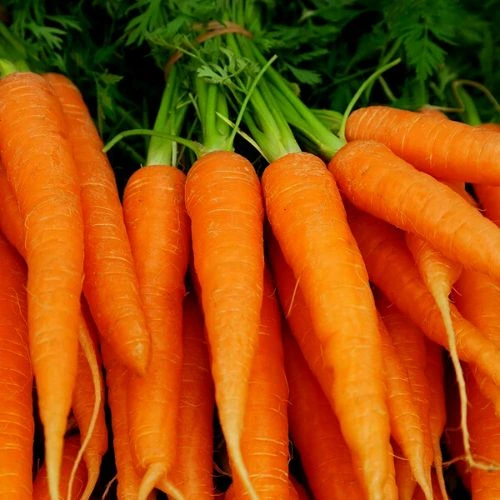
It started as more of yellow color and slowly faded into orange. Much similar to its size and structure. It lengthened and thinned out to become the perfect orange carrot we are used to in today’s world.
Tomatoes
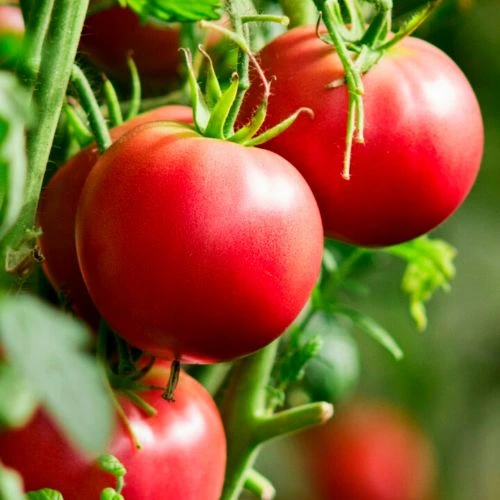
Originally, tomatoes weren’t red. It has been noted that the Aztecs were some of the first to possess tomatoes, but they were smaller and yellow back then. When the Spanish completed their work in that part of the world, they took a heap of them back to Europe.
From then on, the tomato plant has been tinkered with by many different researchers. It is said that there are over 10,000 different varieties of tomatoes these days. They vary in color, shape, size, and physical makeup. From greens to yellows to reds.
Shorter, more stubby variants and longer, thinner types. They are one vegetable (technically a fruit) that have been most modified to suit our human needs over time.
Cucumbers
Just like the tomato, a cucumber is also technically a fruit. Who would have thought? This cool, green, juicy ‘fruit’ was first discovered in the wild in India. Only back then were they known as “Cucumis hystrix,” which was, in fact, a spiky fruit.
That was around 3,000 years ago, though. So through the ages, the English, the Spanish, and the French have added their piece of individuality to them, creating the household cucumbers that we see today.
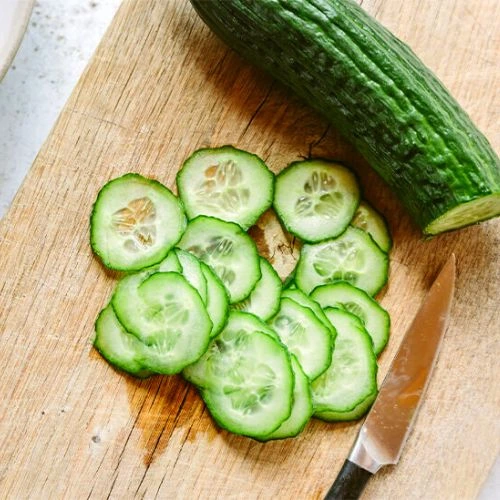
There are now over 100 varieties of cucumber available worldwide. Some of the more common variants include Salad Bush, Spacemaster, Straight Eight, Sugar Crunch, and Sweet Slice, to name a few.
Corn
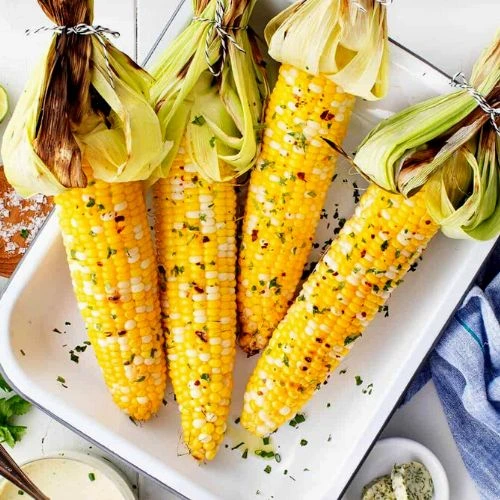
Corn has been poked and prodded for at least 9,000 years. Back then, though, they looked like pine cones and were more of a wild grass teosinte or maize.
It is roughly noted that the Mexicans from the Tehuacan Valley were the first to alter their form in such a way that they managed to create a cob instead of a thin stem.
Of course, this process would have taken quite some time. The results of their tinkering are what we take for granted today.
The Spanish brought some of these plants back from Mexico in the 1500s. Like most of the produce they returned from that region with; it was altered. The size, the shape, and even the colors have been manipulated. There are species of corn that even grow multi-colored on the same cob.
Cruciferous Vegetables
As mentioned above, vegetables such as broccoli, cabbage, Brussel sprouts, cauliflower, and collards came from the humble wild mustard plant. The mustard plant’s flower buds were used to form cauliflower and broccoli.
The leaf buds helped to create the more leafy vegetables, such as cabbage, kale, collards, and brussel sprouts. The stems were gradually mutated into the lesser-known kohlrabi.
What Vegetables Have Not Been Genetically Modified?
Unfortunately, there aren’t many vegetables that haven’t been modified in some way, shape, or form over time. In their earlier forms, most vegetables were grown wild and resemble weeds.
So it’s fair to say that the vegetables that aren’t considered genetically modified grow in the wild.
To some degree, though, seeds and flowers would have been picked up by winds and landed next to each other, causing some minor modifications. You could probably put seaweeds on the list, though, as they are the most untouched by humans over time.
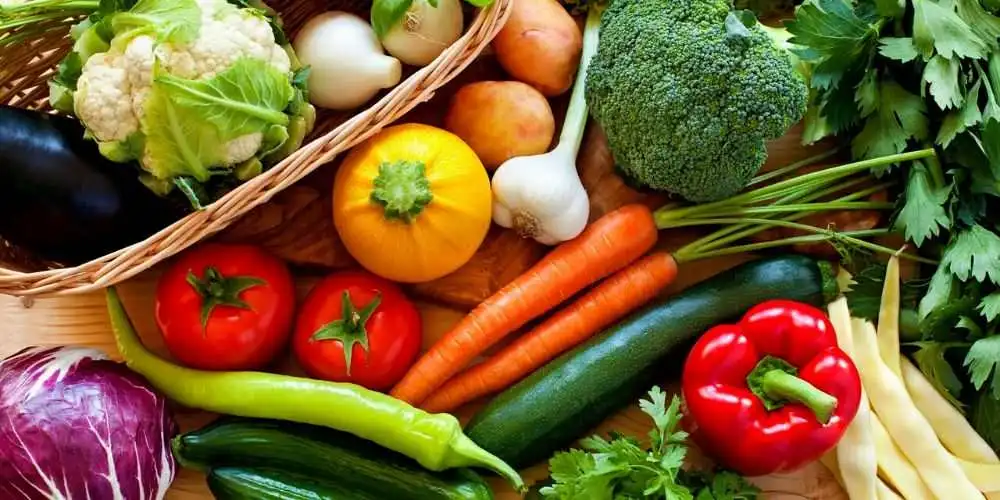
They are becoming more common now, though, as studies have proven their health benefits. The types of vegetable foods left untouched through millennia would be those considered strange or weird because we wouldn’t be able to identify them.
For argument’s sake, though, the least altered household vegetables would be wild forms of things such as dandelions, artichokes, fennel, seaweeds, wild mushrooms, and/or opuntia cacti.
Then you have a range of fruits and nuts that you could add to that category, including pine nuts, strawberry trees, strawberries, blueberries, pecans, agave, Brazil nuts, and many citrus fruits Baobab fruits, and jackfruit. As mentioned, though, nature can still manipulate over time.
Frequently Asked Questions (fAQs)
Is cauliflower a Superfood?
A superfood is generally something with many beneficial nutrients, and cauliflower has exactly that. It’s rich in vitamins B and C. It is also packed with a ton of fiber and natural proteins. To top it all off, it contains carotenoids (antioxidants) and glucosinolates (inhibit cancer by altering the enzymes involved).
Is cauliflower an inflammatory food?
Quite the opposite actually, cauliflower helps to fight inflammation with its high antioxidant content as well as anti-inflammatory compounds.
Can you eat cauliflower every day?
You could eat cauliflower every day. It contains a lot of beneficial vitamins. In saying that, it’s always best to try to consume every food in moderation. Including just one cup of cauliflower per week in your diet will ensure you receive all the nutrients required for that period.
Is cauliflower healthier cooked or raw?
Any vegetable or fruit, for that matter, is best consumed raw. Raw produce contains amino acids which, when eaten, remove the need for protein as they are the form of proteins that don’t require a process to break them down. Not everyone likes it fresh but making things like cauliflower rice and serving it raw in salads is a great way to get those much-needed vitamins into your body.
Is cauliflower good for your liver?
Cruciferous vegetables like cauliflower, brussel sprouts, kale, and cabbage contain a natural compound called Indole. Research has shown that Indole is a key contributor to maintaining and controlling non-alcoholic fatty liver disease (NAFLD).
What happens if I eat too much cauliflower?
There isn’t too much damage caused by excess consumption of cauliflower. Some people who can’t tolerate as much can suffer from gas and bloating. These Cruciferous vegetables can also be a little bit more difficult to digest.
Conclusion
As we have learned, there aren’t many vegetables that man hasn’t manipulated since their discovery. The only vegetables that aren’t man-made would be extremely hard to find in the wild as we wouldn’t even know what to look for.
They would be visually foreign and most likely weeds.
So to answer the question, ‘is cauliflower man-made?’
The simple answer is yes! It was once a humble wild mustard plant that needed adjusting to being more aesthetically pleasing and delicious. We hope that this article has been helpful.


